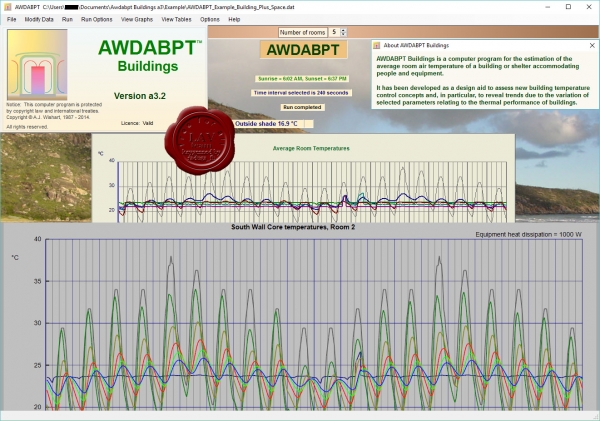
The program calculates the average room air temperature under the given climatic and room thermal load conditions. A heat transfer analysis is performed dynamically over the required time period of up to twenty days. Finite difference numerical methods are used so that the thermal storage effect of the building structure is properly modelled.
A proper solar radiation generator, based on the model for the equation of time and the solar declination, is used. The solar radiation received on a surface can be varied by selection of its solar absorptance (absorption factor), the turbidity factor (haze) of the air and the cloud cover. Re-radiation from external surfaces to the sky is also modelled.
Convection and radiation heat transfer coefficients are calculated during the running of the program at each time increment. The convection coefficients are determined depending on temperatures as well as whether still conditions apply or air movement due to wind (external surfaces) and fans (internal surfaces) occurs.
The equipment building or shelter can be a single zone or comprise up to fifteen rooms. The average room air temperature is determined from a heat flow balance of heat source and sinks such as the equipment, the walls, roof and floor, the room air itself, thermal stores in the room, heat exchangers (room air conditioners, chilled water storage fan-coil units, etc.) and outside air used for room ventilation or entering as infiltration.
The option to include a space that is not an actual room is provided. A space will adjoin one or more rooms and will have a predetermined temperature profile that may be constant or may vary with the attenuated outside shade temperature and/or the adjacent room temperatures.
The option to test the influence of variance in selected input data is provided. Only one type of property, but more than one value, at a time can be selected. The analysis assumes that the range over which a value is to be varied will approximate the normal probability distribution (the bell curve) for the likelihood of its occurrence. The Monte-Carlo method is used.
The relevance of the predictions provided by AWDABPT can be no better than the extent to which the user's input data correctly models the subject building. Further, the accurate modelling of the outside weather conditions may not be fully achievable by this program due to the rapid changes which weather can undergo.